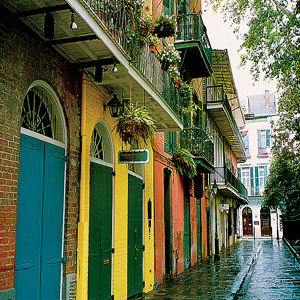The river rose all night
Some people got lost in the flood
Some people got away alright
The river have busted through clear down to Plaquemines
Six feet of water in the streets of Evangeline
Louisiana 1927, by Randy Newman
Stepping foot in New Orleans for the first time in my life, I confess my first thoughts weren’t of the 2004 Katrina debacle, or even of Huey Long, the notorious “Kingfisher” of yore; wandering the streets of Vieux Carré conjured a memory of my own home town. The squat wooden houses lurking under an expanse of blue sky on Burgundy Street (we stayed at the Hotel St. Pierre at the corner of Dumaine) resembled Cincinnati’s Over-the-Rhine section circa my youth. The Southern touch, I reasoned—the Queen City (the first stop on the Underground Railroad once you cross the Ohio River) is about as southern as a northern town gets—and reasoned that as blacks migrated upcountry, certain styles of architecture made the trip as well.
The long Thanksgiving holiday gave luxury to such musings. And though the French Quarter’s tourist trade often brought back the assault of the Manhattan streets I’d left behind, all I had to do to get my bearings was to simply open my ears and listen. There came that accent, an unmistakable drawl that sounded like nothing else on earth. It’s an accent I know well, being the child of Southern-born parents whose journey north tempered their honeyed vowels only slightly.
Those voices furnished our soundtrack as we meandered during cool days that cried out for a sweater. In New Orleans the show is mostly outside, from the antics on Bourbon Street (check out the strippers cajoling single guys on a bender) to some high schoolers playing pretty good guitar down by the riverfront for admirers whose faces were sometimes flecked with powdered sugar (from the beignets at Café du Monde). A break from the chill could be had on the sunny side of streets or inside one of the numerous shops where chewy pecan pralines winked at us from under glass (so good, not too sweet), and the Royal Street galleries displaying everything from gorgeous French antiques to art better suited for display at a strip mall.
Not so at the Ogden Museum of Southern Art, where magisterial works by Bo Bartlett, Dusti Bonge and the photographs of Jonathan Traviesa adorn the walls. The building, designed by the local firm Errol Barron/Michael Toups, is, especially in the catwalk balconies that overlook the lobby atrium, an elegant exercise in the use of glass and brick; its galleries unfold in a series of hallways and nooks that are at once intimate and expansive. The Ogden was a great way to walk off the soul-filling breakfast we had at the Camellia Grill, a worthy streetcar ride on the St. Charles line; on the way you’ll gawk at the Garden District’s stately homes and ponder the possibility of moving there.
Or maybe not. New York it’s not, something I was reminded of the night we dined at LeMeritage, an elegant restaurant housed in the Maison duPuy on Toulouse Street. While me and J shared a pretty wonderful bread pudding a group of folks filed past our table. There was no mistaking the look of contempt we got from the white gentleman bringing up that party’s rear—was it the sight of two men eating from the same dish? Or was the breach of etiquette amplified by the fact that one of us was black? It came as a surprise after the warm encounters we’d had with everyone from strangers eager to point us in the right direction, to the waiters, and especially the bartenders at, respectively, The Bombay Club and the bars Sazerac and Carousel (none to be missed for the best pre-dinner cocktails). In his look I got my reality check: New Orleans, with its anything-goes, party-all-the-time vibe is an absolute destination if you’ve never been. But it’s still the South.


Very much enjoyed your account of your trip (and hope it won’t be your last). I am still feeling sad, though, at your unpleasant experience at Le Meritage–and hope it never happens again. Truly, the city has much to offer, and I would hate to think some random, thoughtless jerk (or insert stronger epithet of choice) had ruined its mysteries for you.
no worries–the B.E. hasnt seen the last of me, nor has the South. Takes more than a ruinous moment to wipe away the good I experienced, which was considerable.
Ennis Smith
Smokin Room (Blog): http://www.smokinroom.typepad.com/
Botticelli Black Boy (Website): http://mysite.verizon.net/ennis.smith/
Dec 10, 2009 04:02:30 PM, reply-3P3NDDDO4UI4_4A799ZFAI7RE@typepad.com wrote: